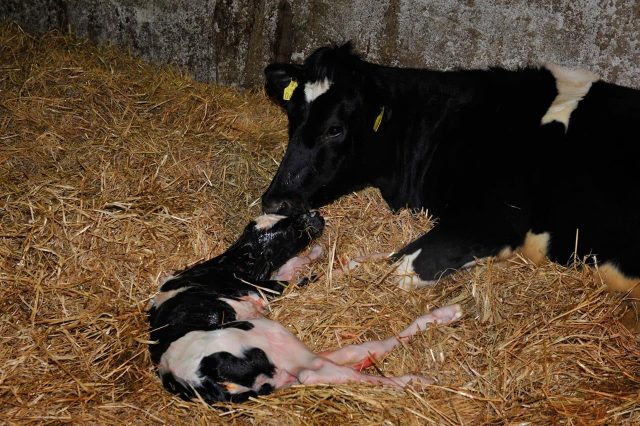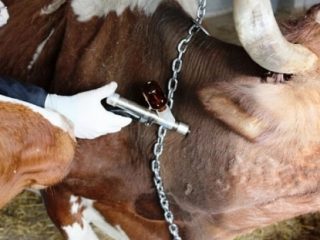Content
The phenomenon when a cow's udder is hard and swollen is not uncommon. Most often, this situation occurs due to a violation of the outflow of lymph and blood circulation immediately after calving. The pathology is considered not dangerous to the health of the animal, but timely action is required.
Why is a cow's udder swollen?
A cow may have a hard udder for several reasons. But those at greatest risk are cattle that have calved for the first time or suffer from heart and kidney diseases. In the presence of any pathologies, edema occurs in the cow several weeks before giving birth, and after calving it does not go away for a long time and only gets worse.
The main causes of the formation of hard edema include the following:
- toxicosis;
- the presence of a large amount of succulent and sour food in the diet;
- heart and kidney diseases;
- lack of an active lifestyle during pregnancy;
- bruises and injuries to the udder.
The danger of edema is as follows:
- udder induration – overgrowth of skin and tissue in the udder, which tends to thicken and lead to a decrease in milk production;
- mastitis – a serious pathology characterized by thickening of the udder, development of suppuration and inflammatory process.
Udder swelling in a heifer
If the udder of a cow that is still pregnant is swollen, this may indicate that the heifer has health problems or is having a hard time with pregnancy. A hard lump in the breast should be a reason to consult a doctor.
Udder swelling before calving
A cow's stone udder can be observed several days before calving. Experienced livestock breeders recommend not to panic in this case, since this is a normal physiological process. Before childbirth, the mammary gland swells, preparing to receive the first portions of colostrum, and hormonal changes occur throughout the body.
Udder swelling after calving
Cattle owners can most often observe edema in the cow after calving. This is a physiological phenomenon that should go away on its own 3 to 4 days after birth. At this time, the owner is recommended to reduce the amount of wet food in the animal’s diet, as well as the amount of liquid consumed.
If after the specified time the problem does not disappear, it is worth starting treatment, since long-term stagnation of milk, which forms in the presence of edema, can cause the development of mastitis and other serious pathologies.
In a first-calf heifer, severe swelling of the udder can be caused by excessive milk flow. In this case, it is recommended to increase the number of milkings and massage the hard areas.
Symptoms of udder inflammation
Not every cow owner can recognize udder swelling.It is usually seen on the back or entire breast. In some cases, alternate swelling of the lobes of the mammary gland occurs. Visually, this can be seen by the following sign: the nipples (back or front) become shorter.
Symptoms of edema include the following:
- the udder is hard, has the “consistency” of dough, that is, there is thickened skin that does not regain its previous shape if pressure is applied to it;
- nipples (usually the rear ones) become shorter;
- temperature is normal;
- the udder is hard, smooth, cold to the touch, looks pale, but painless;
- part of the mammary gland is enlarged;
- Milk when milked has a watery consistency.
How to relieve udder swelling in a cow after calving
Since udder swelling in cows can occur for various reasons, the methods for eliminating them may vary.
If the swelling is postpartum in nature, and the udder is not hard everywhere, then treatment as such is not required. It will take about a week for the problem to go away. If the udder is too hard and bothers the cow, then it is better to start complex therapy immediately. It includes the following manipulations and recommendations:
- frequent milking - at least 6 times a day;
- performing a massage of swelling, which is carried out from the bottom up;
- changing the components of the diet: it is necessary to remove all wet food, introduce a large amount of high-quality hay;
- reducing the amount of fluid consumed;
- treatment with medications.
During treatment, regardless of what nature it will be, you need to adhere to a number of rules that will help speed up the healing process:
- maintaining cleanliness in the area where the cow is kept;
- hand cleaning before milking;
- washing the udder with warm water;
- rubbing cream into the nipples (carry out manipulations before and after milking);
- high-quality milk delivery - violation of milking technique is not allowed;
- udder support with a special corset (any garter that can hold a heavy udder will do). This is necessary so that the animal does not experience discomfort and pain;
- applying lotions from paraffin or hay dust;
- maintaining optimal temperature in the room where the cow spends most of her time.
With the right approach, udder swelling in a cow after calving does not require treatment.
Treatment of udder edema in cattle
If a cow has a hard udder, but this is not associated with calving, then this may indicate the presence of some pathologies. In this case, a hard mammary gland is only a symptom of a more serious disease, which needs to be treated first.
To prescribe effective therapy, it is necessary to establish the exact cause of swelling. This is within the competence of the veterinarian, since each disease has its own characteristics.
- Injury. A hard formation on the udder can be caused by injury. The treatment process in this case will depend on the severity of the injury. Most often, a specialist prescribes Novocaine injections, which relieve pain and reduce inflammation.For severe closed injuries, applying cold to the hard mammary gland may be recommended (effective only in the first hours after the injury). In the following days, heat is applied to the bruise: UHF, thermal baths, etc. If necessary, massage is performed: with light movements, the hard area is rubbed from the bottom up. Severe hematomas are opened to eliminate the bruise (the procedure is carried out no earlier than 3–5 days after the injury). An open wound is treated with antibiotics and sulfa drugs, which are prescribed in a course.
- Mastitis. If a cow has a hardened udder due to the development of mastitis, then the swelling is removed only after the type of disease has been established:
- for catarrhal mastitis, a massage is prescribed, which is carried out from top to bottom, as well as frequent milking;
- serous edema of the udder (mastitis) is treated with frequent milking (every 2 hours) and massage from bottom to top;
- with purulent mastitis, not only a hard udder is observed, but also the presence of painful sensations. In this case, massage is not recommended.
The animal must also be limited in its diet, excluding concentrates and succulent feed. Among the medications that are most often prescribed for mastitis (catarrhal and purulent), solutions of Streptomycin or Penicillin can be distinguished. They are introduced into the udder using a catheter 20 minutes before milking, during which the drugs are removed from the body.
For faster resorption of hard edema, it is recommended to use Iodide and Ichthyol ointments, as well as poultices and wrapping of the udder.
Malignant edema in cattle is rarely diagnosed. But it should not be ruled out either if the problem appeared in a cow that calved several months ago or has not yet been covered.
Many experienced livestock breeders recommend treating the animal not only with medications, but also with traditional medicine, which can soften hard formations and relieve swelling:
- soldering with dill water;
- add chamomile decoction to water intended for drinking to reduce inflammation and relieve swelling;
- apply cabbage leaves to the hard area of the udder: the product helps relieve swelling and moisturizes the skin;
- feed the animal with a decoction of juniper berries, birch buds or horsetail.
Preventive actions
Preventing breast swelling is much easier than treating the resulting consequences. Therefore, it is recommended to take a number of measures to help avoid the development of pathology:
- Most often, the disease can be observed in first-calf heifers, so it is important for them to establish a proper diet (excluding concentrated feed and reducing the amount of succulent feed) and organizing an active pastime;
- the room in which the animal is kept must be in a clean condition. The bedding needs to be changed daily, and during the post-calving period it is better to carry out this procedure twice a day;
- drafts, sudden changes in temperature and high air humidity are unacceptable in the barn;
- Regardless of age, cattle should not receive salt licks during the risk period, and the use of table salt should be kept to a minimum.
A red udder in a cow and its swelling is most often not a disease, but only a symptom of health problems, which must be prevented in the first place.
Conclusion
If the cow's udder is hard but painless, there is no fever or deterioration in general health, then the swelling can be considered not dangerous to health.But in any case, observation of the animal and compliance with a number of provided recommendations is required.











After calving, a month has passed and the udder does not swell. I feed hay, cornmeal/cereals/cereals. 18-20 liters of milk per day